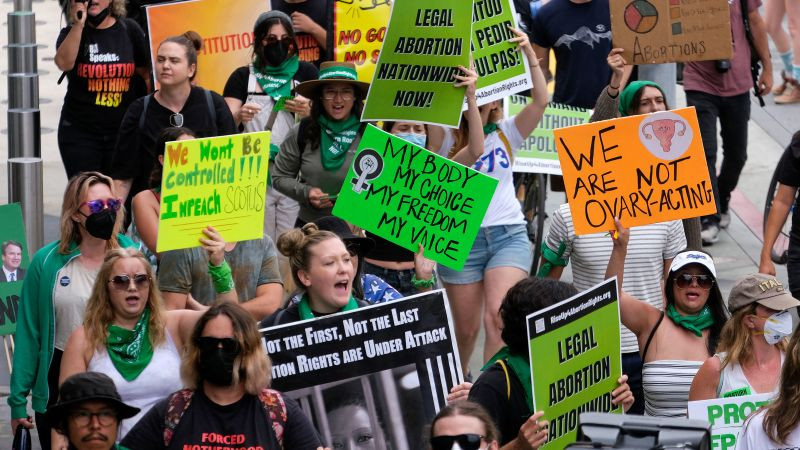The US Supreme Court's decision to overturn Roe v. Wade in 2022 abolished the national right to abortion, but the state-by-state battle for abortion rights is far from over. Since Roe was overturned, 14 states have enacted near-total abortion bans, while four states – Georgia, South Carolina, Florida and Iowa – have banned abortion past roughly six weeks of pregnancy. Other states have enacted laws or held ballot referendums to protect abortion rights.
In a handful of other states, the future of abortion is in flux due to legal challenges. Several states are also likely to hold ballot measures on abortion rights during the November elections, including key battleground states like Arizona and Nevada.
All of this tumult has led to a deeply uneven abortion landscape, with access to abortion clinics cut off across much of the south and midwest but standing strong on both coasts. The map below shows where state abortion laws stand as of 29 July 2024.
State Abortion Laws: A Map of Access
Across America, including in conservative states like Nebraska and Arkansas, every proposed ballot measure to restore or expand abortion access gathered enough signatures to make November's ballot. Voters in 11 states this fall could vote on abortion, if those signatures are certified and the measures survive legal challenges.
Ballot Measures: A Test of Public Opinion
For 50 years, the U.S. Supreme Court's Roe v. Wade decision gave women in America access to abortion until fetal viability, around the 24th week of pregnancy. The Dobbs decision in 2022 overturned those national protections for abortion, and states adopted a range of policies, from near total bans to broad access in line with the Roe standard.
In states that allow voter-driven ballot measures, abortion rights groups have used the tool to push back against restrictions. In past elections, voters even in conservative states like Ohio and Kansas have shown a willingness to support these abortion ballot measures.
Now, abortion could become an even more high-profile issue come November. Vice President Kamala Harris, the likely Democratic presidential nominee, has been a forceful advocate for abortion access and will likely make the issue central in her campaign against Republican Donald Trump.
“I've been doing this work for a long time, and I've never felt the kind of energy and enthusiasm that we currently have with Americans across the county,” said Caroline Mello Roberson of Reproductive Freedom for All, an abortion rights advocacy group that campaigned for ballot measures campaigns in Arizona, Nevada and Michigan.
A State-by-State Breakdown
Here is where proposed abortion ballot measures stand across the country:
Arizona: Restoring Abortion Access
Arizona made national news in April when the state's Supreme Court upheld an 1864 law that imposed a near total ban on abortion. The legislature later overturned that Civil War-era law. Abortion rights organizers collected more than 800,000 signatures, double the amount needed, for a constitutional amendment that would create a right to abortion up until the fetus becomes viable.
Arkansas: Overcoming Obstacles
Despite no support from national abortion rights groups, organizers gathered more 100,000 signatures for a proposed constitutional amendment that would allow unrestricted abortions in the first 18-weeks after fertilization with exceptions later in the pregnancy for rape, incest and the mother's health. The Arkansas Secretary of State rejected the submitted signature due to a missing form, but the organizers filed suit to challenge that decision. Current Arkansas law allows abortion only to save the mother's life, and no abortions were performed in the state last year.
Colorado: Strengthening Existing Protections
Colorado already has extensive protections for abortion, including laws shielding doctors who perform abortions on patients from out of state. But a ballot initiative led by reproductive rights supporters would enshrine the right to abortion in the state constitution. The initiative would also bar the government from prohibiting the coverage of abortions through health insurance plans, including for public employees and for publicly funded health care plans. An opposing initiative aimed at banning abortion failed to gather enough signatures to get on the ballot.
Florida: Reversing Restrictions
In May, Florida banned almost all abortion after six weeks of pregnancy. Before that law went into effect, the state had some of the least restrictive abortion laws in the Southeast, and more than 7,000 women traveled to the state from across the region for the procedure. A voter-driven measure already approved for the November ballot, however, would restore abortion access up to fetal viability. The measure must be approved by 60% of the voters to pass.
Maryland: Expanding Protections
A ballot measure, proposed by the state legislature, would enshrine abortion protections in the state's constitution. Current state laws, enacted by a voter-driven ballot initiate in 1991, provide broad access to abortion.
Missouri: Scaling Back Restrictions
Reproductive rights supporters in Missouri are attempting to scale back the state’s near total abortion ban through a ballot initiative that would enshrine the right to the procedure in the state's constitution. Missourians for Constitutional Freedom, a coalition of abortion rights activists, submitted more than 380,000 signatures in May, which local election officials have until July 30 to certify. The group has faced challenges from anti-abortion groups, which have led an aggressive “Decline to Sign” campaign.
Montana: Protecting Existing Rights
Abortion rights proponents in Montana recently submitted 117,000 signatures, nearly double the required amount, for a ballot initiative that would enshrine the right to abortion in the Montana Constitution. Currently, abortion is legal in the state up to fetal viability. The campaign had less than 80 days to collect signatures after Attorney General Austin Knudsen challenged the initiative in court, narrowing the signature collection window.
Nebraska: A Tight Race
Two opposing ballot initiatives submitted signatures: one aiming to enshrine the state's current 12 week abortion ban in the Nebraska Constitution, and the other seeking to extend abortion access up to fetal viability. Protect Our Rights, the group supporting abortion access in the state, broke a record for the number of signatures submitted for a ballot initiative in Nebraska with around 207,000. Protect Women and Children, the anti-abortion campaign, came in close with 205,000 signatures in only 97 days. If both initiatives make it on the ballot, the one that receives the most votes in November will pass.
Nevada: Enacting Constitutional Protections
In June, a ballot initiative enshrining abortion rights in the Nevada Constitution got the green light for the November ballot after receiving more than 200,000 signatures. Nevada currently has a 1990 law in place allowing abortions for the first 24 weeks of pregnancy or later to protect the health of the pregnant person. The proposed amendment would enshrine this access in the state constitution. Voters would have to approve the initiative in both 2024 and 2026 to amend the state constitution.
New York: Expanding Rights
The Equal Rights Amendment, a constitutional amendment put forward by state lawmakers, would bar discrimination against a woman who had an abortion. New York allows abortions through the 24th week of pregnancy. The amendment would also bar discrimination based on sexual orientation, gender identity, ethnicity and national origin.
South Dakota: Preserving Access
South Dakotans will decide whether to enshrine abortion rights into the state constitution this November after a ballot initiative aiming to do so was approved in May. Along with scaling back the state’s near total abortion ban, the initiative would allow for abortions in the first trimester while also allowing the state, in the second trimester, to “regulate the pregnant woman’s abortion decision and its effectuation only in ways that are reasonably related to the physical health of the pregnant woman.” The amendment would also create an exemption for abortions to “preserve the life and health” of the woman in the third trimester.
The Stakes Are High
The November elections will be a critical test of public opinion on abortion access, and the outcomes could have a profound impact on the future of reproductive rights in the United States. As the battle lines are drawn, the focus is shifting from the courts to the voters, and the fight for reproductive freedom is taking on a new level of intensity.

















